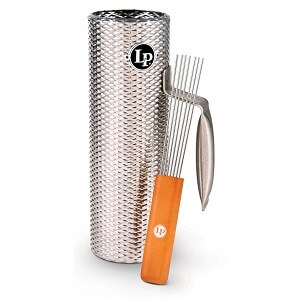Guira
 The guiro instrument is a long, hollow gourd with ridges that produce sound when a stick, called a pua, is scraped along the sides of the instrument. The guiro is classified as a percussion idiophone because the entire instrument vibrates to create sound. Popular in Latin American music and a staple of worldwide dance rhythms, this percussion instrument has been around for hundreds of years and continues to gain popularity.
The guiro instrument is a long, hollow gourd with ridges that produce sound when a stick, called a pua, is scraped along the sides of the instrument. The guiro is classified as a percussion idiophone because the entire instrument vibrates to create sound. Popular in Latin American music and a staple of worldwide dance rhythms, this percussion instrument has been around for hundreds of years and continues to gain popularity.
The guiro sound is most often associated with the Puerto Rican and Cuban musical genres of son, trova, and salsa, as a rhythm accompaniment. The instrument is typically included in a percussion ensemble or played by a singer. Like maracas or claves, the guiro keeps time during a performance, making it a popular instrument for a lead singer. In addition to Latin music, the guiro is also found in the percussion sections of Western classical orchestras, sometimes referred to as a ‘grater’ in musical scores. The first guiro was first included in Latin orchestral pieces and later adopted by European composers.
Guiros are played by holding the gourd in the palm of the left hand with the thumb held in a sound hole on the back. Some guiros have two sound holes, meant to be held with the thumb and finger. These holes help the player keep the guiro steady and in place while playing fast or complex rhythms. Some guiros have an elongated handle at one end without ridges where it’s meant to be held—these handles are typically only a part of traditional gourd guiros. The pua is held by the right hand and moved along the notches in the instrument to create a rasping sound.